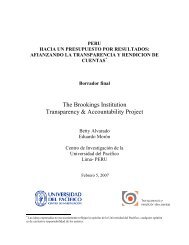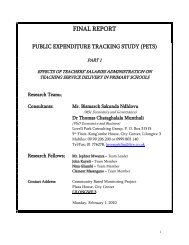Provider Purchasing and Contracting for Health Services_The Case
Provider Purchasing and Contracting for Health Services_The Case
Provider Purchasing and Contracting for Health Services_The Case
You also want an ePaper? Increase the reach of your titles
YUMPU automatically turns print PDFs into web optimized ePapers that Google loves.
1. Introduction<br />
Re<strong>for</strong>ms in the health sector oriented toward the marketization of health care emerged during<br />
the late 1980s <strong>and</strong> early 1990s in low- <strong>and</strong> medium-income countries as part of an identified<br />
need <strong>for</strong> greater efficiency <strong>and</strong> effectiveness of health sector per<strong>for</strong>mance. <strong>The</strong>re were two<br />
key dimensions to the re<strong>for</strong>ms: first, strategies targeting direct or indirect private sector<br />
participation through public-private partnerships <strong>and</strong>, second, a per<strong>for</strong>mance-oriented focus<br />
of the public sector (Saltaman R. B 1995; Mills A1995). In fragile states, contracting has<br />
been introduced by donors to address the lack of appropriate health services in a country or<br />
the breakdown of health infrastructure. <strong>The</strong> choice of contracting is underpinned by the<br />
notion that public service agents tend to act inefficiently because they wield bureaucratic<br />
control over resources, <strong>and</strong> this adversely affects efficiency in health care provision. <strong>The</strong><br />
creation of internal markets within the public <strong>and</strong> contracting out services in the public <strong>and</strong><br />
private sectors lead to a weakening of bureaucratic control, while introducing a per<strong>for</strong>mancebased<br />
framework <strong>for</strong> service delivery that is also diversified by including public, private <strong>for</strong>profit,<br />
<strong>and</strong> private not-<strong>for</strong>-profit providers (Walsh 1995; Mills, 1998). Moreover, with<br />
contracting, government gains authority in its regulatory <strong>and</strong> oversight roles <strong>and</strong> private<br />
agents evolve from competitors to collaborators. This helps to harness private sector<br />
resources <strong>and</strong> capture some of the advantages of competitive markets or ensure that services<br />
are provided to the wider communities.<br />
Despite the rapid growth of the private sector <strong>and</strong> obvious complementarities with the public<br />
sector, most governments <strong>and</strong> the global health community have not adequately monitored<br />
<strong>and</strong> engaged the private sector to exploit its competitiveness in meeting the health needs of<br />
communities. Moreover, very few studies have been undertaken to underst<strong>and</strong> the private<br />
sector <strong>and</strong> the role that it could play in the health system. Meanwhile most patients, including<br />
the poor, seek health care from the private sector as the first source of health care (Mills,<br />
Brugha et al. 2002).<br />
Generally, governments in developing countries have attempted to harness the private sector<br />
by focusing on vertical contracting in addressing areas of public health programs <strong>and</strong> diseases<br />
such as TB <strong>and</strong> HIV/AIDs. This is in spite of the abundant evidence that shows that the<br />
private sector can effectively contribute to improved per<strong>for</strong>mance of the entire health sector<br />
once embraced as part of the health system (Kistnasamy 2008). Unlike initiatives that address<br />
vertical approaches to private sector participation, this study explored models <strong>for</strong> integrating<br />
both public <strong>and</strong> private health resources to create a comprehensive health system better<br />
equipped to achieve improvements in health outcomes based on the Zambian experience.<br />
Socioeconomic profile<br />
Zambian socioeconomic indicators have remained mixed during the period 2002 <strong>and</strong> 2006.<br />
While there have been improvements in some indicators, some have worsened <strong>and</strong> others<br />
have remained static at suboptimal levels (table 1), <strong>and</strong> this has been of great concern to<br />
policymakers. As a result, like other developing countries, Zambia has committed itself to the<br />
realization of the Millennium Development Goals on health by 2015. 1 According to the<br />
1 See www.unmillenniumproject.org/goals/ <strong>for</strong> a full description of the Millennium Development Goals.<br />
1
















